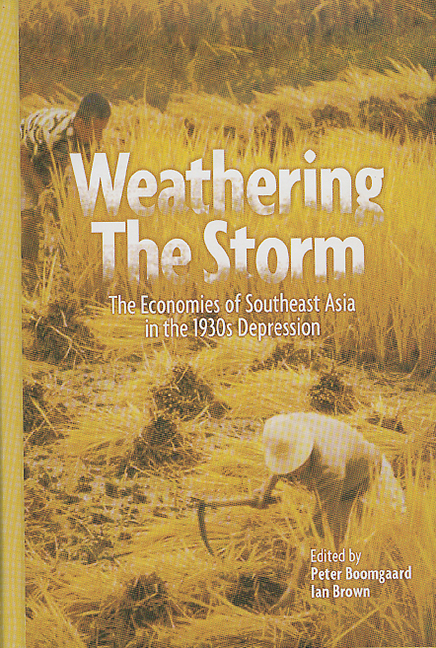Book contents
- Frontmatter
- Contents
- List of Tables
- List of Figures
- Acknowledgements
- List of Contributors
- 1 The Economies of Southeast Asia in the 1930s Depression: An Introduction
- PART I MATERIAL CONDITIONS
- PART II AGRICULTURAL STRATEGIES
- 6 Structural Origins of the Economic Depression in Indonesia During the 1930s
- 7 Entrepreneurial Strategies in Indigenous Export Agriculture in the Outer Islands of Colonial Indonesia, 1925-38
- 8 The Economy of Besuki in the 1930s Depression
- 9 The Rice Economy of Thailand in the 1930s Depression
- 10 Rice and the Colonial Lobby: The Economic Crisis in French Indo-China in the 1920s and 1930s
- PART III TRADING COMMUNITIES
- PART IV THE STATE'S RESPONSE
- Index
10 - Rice and the Colonial Lobby: The Economic Crisis in French Indo-China in the 1920s and 1930s
from PART II - AGRICULTURAL STRATEGIES
Published online by Cambridge University Press: 21 October 2015
- Frontmatter
- Contents
- List of Tables
- List of Figures
- Acknowledgements
- List of Contributors
- 1 The Economies of Southeast Asia in the 1930s Depression: An Introduction
- PART I MATERIAL CONDITIONS
- PART II AGRICULTURAL STRATEGIES
- 6 Structural Origins of the Economic Depression in Indonesia During the 1930s
- 7 Entrepreneurial Strategies in Indigenous Export Agriculture in the Outer Islands of Colonial Indonesia, 1925-38
- 8 The Economy of Besuki in the 1930s Depression
- 9 The Rice Economy of Thailand in the 1930s Depression
- 10 Rice and the Colonial Lobby: The Economic Crisis in French Indo-China in the 1920s and 1930s
- PART III TRADING COMMUNITIES
- PART IV THE STATE'S RESPONSE
- Index
Summary
The purpose of this chapter is to investigate and analyse some of the causes of the crisis in Indo-China in the 1920s and 1930s, in the context of the world crisis of 1929. How deep was the crisis, what were its main causes, how did it affect the north and the south of Vietnam, and whom did it affect? The approach here is to use empirical sources, which provide information on a year-by-year basis. Of particular importance is the Annuaire Statistique de l'Indochine, although it has obvious weaknesses: like most French sources of that period, it was more concerned with those economic factors which involved the relationship with France than with the actual situation in Indo-China. The Annuaire Statistique is, however, one of the few sources which allow for analysis of annual changes over longer periods of time. It is important to investigate changes in production and trade during the crisis in order to understand its causes and impact.
The structure of the chapter is as follows. The first section deals with the context of the crisis and its main feature; then follows a discussion of the structure of agriculture in north and south Vietnam and in Cambodia; the impact of the crisis in the north and the south; the importance of the French colonial lobby in securing protection for rice; and finally the foreign trade of Indo-China during the crisis is set in the context of longer- term trends.
The two central concerns of the paper are: the role of French colonial policy during the crisis: and the ways in which the more commercialized south reacted to the crisis, compared to the impact in the more subsistence- oriented north. The broad thesis is that the greater the level of integration into the world market, the greater the impact of the world crisis on the local society.
- Type
- Chapter
- Information
- Weathering the StormThe Economies of Southeast Asia in the 1930s Depression, pp. 198 - 226Publisher: ISEAS–Yusof Ishak InstitutePrint publication year: 2001

